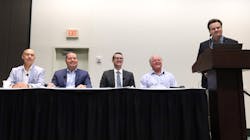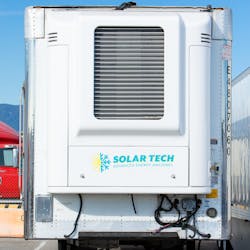As the emissions rules and regulations have tightened across the U.S., and particularly in California, a plethora of solutions for reducing trucking’s carbon footprint have entered the spotlight, from hydrogen fuel cells to electric vehicles (EVs). But the path to zero emissions is even more difficult for refrigerated trailers than their dry-van brethren, given the energy needed to power the truck and control the temperature of their load.
To help inform reefer carriers of their options, the International Foodservice Distributors Association presented the panel ‘Hype or Reality: The Rise of the EV Refrigerated Trailer’ during its 2023 Solutions Conference on Sept. 12 at the Fort Worth Convention Center.
The panel featured several industry leaders, including Chris Tanaka, VP of product management, Thermo King; Marc Trahand, VP and GM at ConMet; Robert Koelsch, CEO, Advanced Energy Machines; Ryan Kemet, business development, eNow; and, as moderator, Don Durm, solutions VP at PLM Fleet. Throughout their conversation, the panelists covered the forces pushing reefer fleets to decarbonize, the critical success factors for EV technology and why to adopt it, and how refrigerated fleets can begin the EV transition.
The drive to electrify
Primary among the reasons to electrify reefer fleets is the growth of federal and state regulations, such as those that will comprise the Environmental Protection Agency’s Clean Trucks Plan, the first rules of which passed at the end of 2022 and increased emission reduction requirements for 2027 model-year engines.
Trahand guessed even stricter regulations could be on the way, perhaps like those already in Europe.
“There are zones where you cannot have anything other than zero-emission vehicles,” Trahand said. “Those emissions zones haven't really been implemented here in the U.S., but that's something that could come at some point. We've heard about California thinking about that as well.”
However, the panelists recognized that while enforcing regulations can come down to black-and-white terms of passing or failing, actually transitioning reefer carriers from diesel to zero emissions encapsulates several shades of gray in terms of training, education, and technological development. As a result, they argued that while regulation is still in development, it’s important for refrigerated transportation companies to act quickly to take advantage of the process.
“On the regulation side, we're seeing a push toward zero emissions and a push toward decarbonization, which is ultimately going to result in something becoming a law, at which point there will normally be no more incentives,” Trahand noted. “We need to work together as an industry to figure out how to influence these regulations and make sure they're practical.”
This is particularly true given that while many states, such as California, are willing to incentivize the move to electric vehicles in many segments, refrigerated carriers don’t always have the same opportunity.
“Incentives today are both at the federal level and the state level, but the biggest state that we will raise concern about today is California,” Trahand continued. “The biggest issue we have at the federal level is that in the IRA and IAJ today, there's half a trillion dollars, but there's nothing right now for refrigerated transport.”
This is a significant disadvantage, given that at 2023’s American Trucking Associations’ Technology & Maintenance Council Meeting, the ‘Powertrains of the Future!’ panel found that it took $27 million to deploy 50 chargers and electric vehicles for the Joint Electric Truck Scaling Initiative. With a price tag like that, the panel emphasized that investing, pre-planning, and encouraging incentives for refrigerated electrification, has to happen sooner than later.
“Right now is the time because these changes are happening,” Kemet said. And for those businesses that begin grappling with electrification earlier, even with only a single unit, they’ll have a better idea of what their operation needs for the process, how that relates to regulations, and what operational changes they’ll need.
“If you’re doing that five years from now, if you want to have that goal, at that point in time you're going to be too late to get there, it's going to cost you a lot more money to do it then, than to start earlier, both from an incentive perspective and just from a learning perspective,” Kemet emphasized.
Critical success factors
While the price tag for electrification may be high, the ‘Hype or Reality’ panelists also stressed the benefits that companies who make the transition can and should see. These range from saving on operational costs, work toward sustainability goals for carriers and their customers, and even employee happiness.
“Operationally, people see substantial savings in [electric], of course, but people also just like it,” Koelsch observed. “It's clean, it's quiet, it's efficient. They recognize they're doing something for the future.”
“Avoiding diesel, you’re going to get happier employees as well, who don’t have to breathe those fumes all the time,” Trahand agreed.
Then, of course, there’s the environmental benefits. Koelsch reported that transitioning to electric transport refrigeration units (eTRUs) can reduce enough carbon to account for 50% of an organization’s carbon budget. In a state like California, this means that the costly move to electric can pay itself back in 3-4 years.
Even more specifically, Trahand argued that going electric for reefer trailers will not only pay for itself, but lower a fleet’s hidden costs in maintenance, too.
“Cost savings, at the end of the day, is one of the main reasons we're going electric,” Trahand continued. “Of course, zero emissions comes in the same segment as well. Ultimately, you're going to see the total cost of ownership go down, whether it's maintenance or the electric side.”
Getting started
Knowing the costs, and potential payback, for electric, the first question for reefers comes down to the ratio between operational spending and sustainability goals and deadlines.
“How much are you willing to spend for how many tons of carbon you reduce?” Kemet asked. “Developing that number really helps when you're looking at, ‘Okay, I can either purchase cleaner power or start to change out my fleet.’ As that number starts to approach zero or go negative, it makes the decisions a lot easier.”
Then fleets need to compare this number to their sustainability goals, such as Thermo King’s goal “to reduce our customers’ emissions by over a billion metric tons by 2030 and to be zero net energy by 2050,” as Tanaka stated. To meet such goals, fleets need to know how long it will take for change-outs and purchase decisions, and incorporate those timeframes into their plans.
Such plans also must incorporate infrastructure development, which can take months or years to implement on a single parking lot. Questions reefer fleets might not have anticipated could come up, such as who owns the parking lot where chargers are going to be installed.
Then, the process may be complicated for a carrier with dealers in multiple locations, who then needs to contend with EV charging with multiple utility providers, all of whom may have varying price rates at different times of day, depending on usage.
“Having the infrastructure readiness at the single-customer level and having the multi-customer readiness to supply power to all those customers are important milestones to be ready to move at scale,” Tanaka explained.
After all that, the next step is to consider how the transition to EV will effect a fleet’s operations. These types of questions can vary from EV range limits to the increase in weight due to heavier batteries.
“You can buy as much range as you can hang on there,” Tanaka advised. “These aren’t exact records, but if you are willing to spend more and able to take more weight penalty, you can extend the range. But in practical terms, this is a not insignificant weight that has been added, a couple thousand pounds.”
This means that reefer fleets will need to plan their routes and freight loads more carefully, depending on whether their vehicles return to the depot each night or will be spending them out on the open road. If it’s the former, this may mean that a vehicle will have to return to the distribution center to recharge after each route, and charging a reefer while it’s being loaded in the yard. For the latter, reefer carriers need to keep in mind charger and plug-in placements to ensure they have ‘refueling’ options throughout the day.
“There might not necessarily be a power infrastructure that you’re going to be able to use out in the world today, so really, the rest of that power [before a trip] is going to come from your distribution center,” Kemet warned.
Charging ahead
But fleets don’t need to develop such charging plans entirely from scratch.
“You probably use electric forklifts in your warehouses every day,” Koelsch said. “If you lean on your forklift people a little bit more than you have, they have a lot of answers sitting right there. The charging schedules that you have for forklift usage, it's the same for an electric TRU.”
A good charging plan could also mean having power redundancies on hand, such as solar options and battery packs, to supplement typical charging methods, especially if an area is experiencing brownouts.
While all of these elements can be overwhelming, the EV reefer panel emphasized that the EV transition, at it’s core, is a learning experience—and there’s no better time to charge ahead than the present.
“Why not do it right now?” Koelsch asked. “Down the road, years from now, [you’ll be glad] you got to get into the technology and began to understand it, and manipulate it to your benefit. And you can do that in California today.”
This article was originally published on Refrigerated Transporter.






